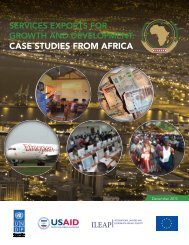BUDGET
budget
budget
You also want an ePaper? Increase the reach of your titles
YUMPU automatically turns print PDFs into web optimized ePapers that Google loves.
58 MEETING OUR GREATEST CHALLENGES: OPPORTUNITY FOR ALL<br />
increase rural families’ access to promising and<br />
evidence-based programs and services. The<br />
Budget makes unprecedented investments in<br />
two-generation approaches—aligning high-quality<br />
early childhood education for children with<br />
high-quality workforce development for parents<br />
to put the entire family on a path to educational<br />
success and permanent economic security. The<br />
Budget provides $20 million for two-generation<br />
demonstration projects within USDA to fight<br />
rural child poverty and $16 million to support<br />
an integrated model for early childhood development<br />
and parental involvement for American<br />
Indian families in BIE-funded schools. As discussed<br />
above, the Budget also introduces a new<br />
rural home visiting program that complements<br />
HHS’s evidence-based Maternal, Infant, and<br />
Early Childhood Home Visiting program to serve<br />
more high-risk, high-need children and families<br />
in remote rural areas.<br />
Promoting Permanency, Safety, and Well-<br />
Being for Children and Youth in Foster<br />
Care. On any given day, there are more than<br />
400,000 young people in the Nation’s foster care<br />
system, with over 100,000 waiting to be adopted.<br />
The Budget includes a package of investments<br />
designed to do more to prevent the need for foster<br />
care and assist children and families so that children<br />
can either be reunited with their biological<br />
parents or placed in a permanent home where<br />
they can thrive. The Budget includes funding to<br />
provide critical preventative services to vulnerable<br />
families and children to address hardships<br />
early, keeping more children out of foster care<br />
and with their families, as well as funding to<br />
promote family-based care for children with behavioral<br />
and mental health needs to reduce the<br />
use of congregate care—which can have negative<br />
effects on children. The Budget also provides<br />
funding to help improve the training and skills<br />
of the child welfare workforce, individuals working<br />
with some of the most vulnerable children<br />
and youth in the Nation, including funding to<br />
help caseworkers obtain a Bachelor or Master’s<br />
degree in social work and incentivize State child<br />
welfare agencies to hire and retain caseworkers<br />
with this specialized education. The Budget<br />
continues to include funding for Tribes to build<br />
their child welfare infrastructure, and for tribal<br />
children and youth removed from their homes to<br />
remain in their communities.<br />
Improving Health Outcomes for Children<br />
and Youth in Foster Care. The Budget continues<br />
to propose a Medicaid demonstration project<br />
in partnership with HHS’s Administration for<br />
Children and Families to encourage States to<br />
provide evidence-based psychosocial interventions<br />
to address the behavioral and mental<br />
health needs of children in foster care and reduce<br />
reliance on psychotropic medications to improve<br />
overall health outcomes.<br />
Helping Families Achieve Self-Sufficiency<br />
through the Upward Mobility Project.<br />
The Budget continues to support the Upward<br />
Mobility Project, which would allow up to 10<br />
communities, States, or a consortium of States<br />
and communities more flexibility to use funding<br />
from up to four Federal programs for efforts<br />
designed to implement and rigorously evaluate<br />
promising approaches to helping families achieve<br />
self-sufficiency, improving children’s education<br />
and health outcomes, and revitalizing communities.<br />
Projects will have to rely on evidence-based<br />
approaches or be designed to test new ideas, and<br />
will have a significant evaluation component<br />
that will determine whether they meet a set<br />
of robust outcomes. The funding streams that<br />
States and communities can use in these projects<br />
are currently block grants—the Social Services<br />
Block Grant, the Community Development<br />
Block Grant, the Community Services Block<br />
Grant, and the HOME Investment Partnerships<br />
Program—that share a common goal of promoting<br />
opportunity and reducing poverty, but do not<br />
facilitate cross-sector planning and implementation<br />
as effectively as they could. The Budget<br />
also provides $1.5 billion in additional funding<br />
over five years that States and communities can<br />
apply for to help support their Upward Mobility<br />
Projects.




